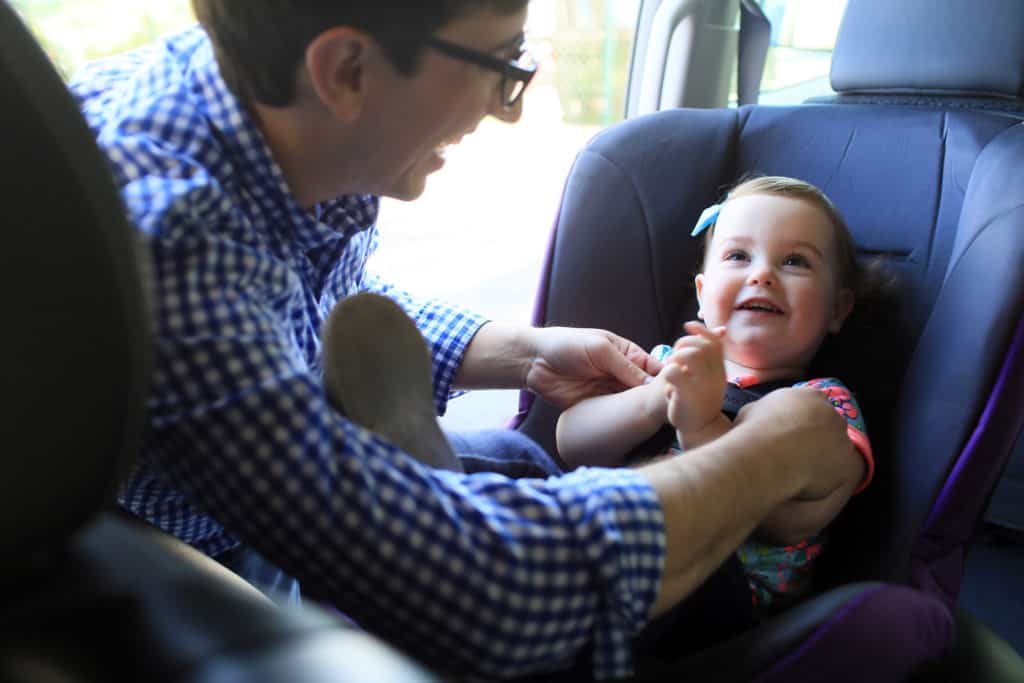
National Child Passenger Safety Week reminds parents that child safety seats help save lives in crashes. When installed and used correctly, child safety seats decrease the risk of a fatal injury by 71percent among infants, 54 percent among toddlers and 45 percent among children ages 4 to
8.
This month, in honor of National Child Passenger Safety Week The Bump and Buckle Up for Life, the national car seat safety program from Cincinnati Children’s and Toyota, are teaming up to help keep the littlest passengers safe on the road. For each baby registry created on The Bump website or on its 5-star rated mobile app in September, Buckle Up for Life will provide a new car seat to a family in need as well as educate recipients on the correct way to install it.
Make sure children are properly buckled up in a car seat, booster seat, or seat belt, whichever is appropriate for their age, height, and weight.
- Birth up to age 2 – Rear-facing car seat. For the best possible protection, infants and children should be buckled in a rear-facing car seat, in the back seat, until age 2 or when they reach the upper weight or height limits of their particular seat. Check the seat’s owner’s manual and/or labels on the seat for weight and height limits.
- Age 2 up to at least age 5 – Forward-facing car seat. When children outgrow their rear-facing seats they should be buckled in a forward-facing car seat, in the back seat, until at least age 5 or when they reach the upper weight or height limit of their particular seat. Check the seat’s owner’s manual and/or labels on the seat for weight and height limits.
- Age 5 up until seat belts fit properly – Booster seat. Once children outgrow their forward-facing seat (by reaching the upper height or weight limit of their seat), they should be buckled in a belt positioning booster seat until seat belts fit properly. Seat belts fit properly when the lap belt lays across the upper thighs (not the stomach) and the shoulder belt lays across the chest (not the neck). Remember to keep children properly buckled in the back seat for the best possible protection.
- Once seat belts fit properly without a booster seat – Children no longer need to use a booster seat once seat belts fit them properly. Seat belts fit properly when the lap belt lays across the upper thighs (not the stomach) and the shoulder belt lays across the chest (not the neck). For the best possible protection keep children properly buckled in the back seat.
- Install and use car seats and booster seats according to the seat’s owner’s manual or get help installing them from a certified Child Passenger Safety Technician.
Buckle all children ages 12 and under in the back seat. Airbags can kill young children riding in the front seat. Never place a rear-facing car seat in front of an airbag.
- Buckle children in the middle of the back seat when possible, because it is the safest spot in the vehicle.
- Buckle children in car seats, booster seats, or seat belts on every trip, no matter how short.
- Set a good example by always using your seat belt.
Non-Fatal Injury Data
- In 2015, there were more than 427,000 visits to Emergency Departments by children due to
motor vehicle collisions. - Teenagers account for 76 percent of MVC fatalities among children and die at more than 7
times the rate of children under 14 (9.5 per 100,000 teens versus 1.3 per 100,000 children 0 to 13 years). - Boys are more likely to suffer fatal MVC injuries than girls- 62 percent of fatalities are among
boys and 38 percent among girls. - Almost half (48 percent) of all children killed during MVCs in 2015 were unrestrained, and teens were less likely to be restrained than those under 14 years. The proportions of unrestrainedfatalities by age group were 52 percent for teens, 41 percent for children ages 9 to 13 years, and 31 percent for children under 9 years.
To find a safety seat check event in your area, visit seatcheck.org.
Buckle Up for Life reaches families in powerful ways by partnering with local children’s hospitals and community organizations, such as churches and community centers. Buckle Up for Life‘s website offers digital resources in English and Spanish, including tips and videos on car seat installation. The site is optimized for mobile, so users can access information on the go on smart phones or tablets. Buckle Up for Life has reached more than 65,000 people across the country with free car seats and education since its founding in 2004.